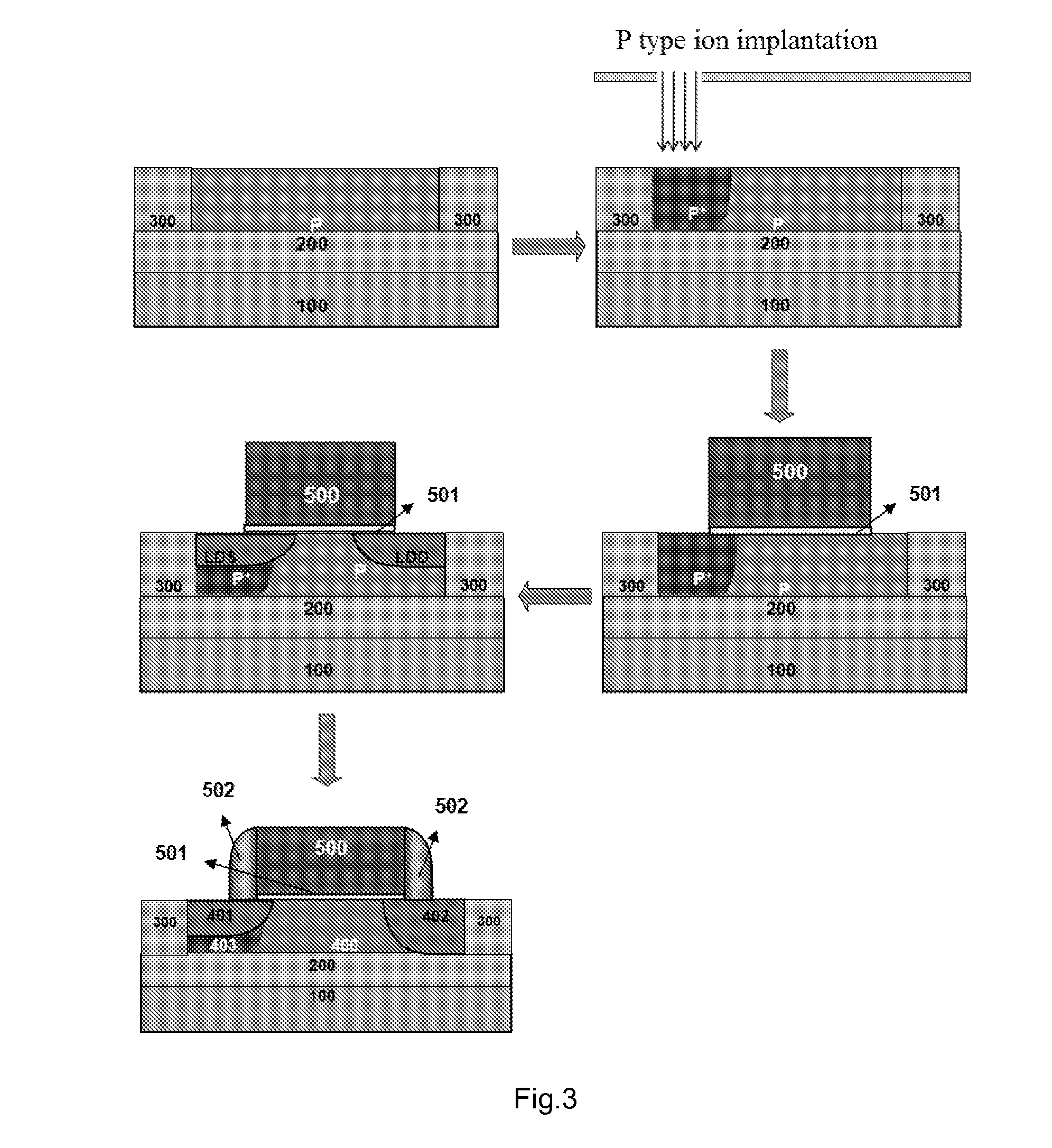MOS Structure with Suppressed SOI Floating Body Effect and Manufacturing Method thereof
a floating body effect and mos technology, applied in the direction of basic electric elements, electrical apparatus, semiconductor devices, etc., can solve the problems of low threshold voltage of fdsoi, high cost of thin film soi silicon, and inability to quickly transfer charge due to impact ionization mechanism, etc., to achieve the effect of not increasing the chip area
- Summary
- Abstract
- Description
- Claims
- Application Information
AI Technical Summary
Benefits of technology
Problems solved by technology
Method used
Image
Examples
example i
[0025]Referring to FIG. 3 of the drawings, this example provides a method of manufacturing MOS structure with suppressed floating body effect comprises the following steps.
[0026]Firstly, create a shallow trench isolation structure 300 on a semiconductor material, such as SOI (silicon on insulator) or GOI (germanium on insulator), having a buried insulation layer 200, to isolate an active area, and implant P ion into the active area. Add a mask on the active area, create an opening on the mask at a position of a first conductive type source region 401, and vertically highly implant P ions into the active area into via the mask forming a highly doped P region. Create a gate dielectric layer 501 and gate electrode 500. Lightly dope a source region and a drain region. Implant N ions into the source region and source region forming a first conductive type region 401 and a first conductive type drain region 402 and a body region 400 between the first conductive type region 401 and the fir...
example ii
[0027]Referring to FIG. 4 of the drawings, this example provides a second method of manufacturing MOS structure with suppressed floating body effect comprises the following steps.
[0028]Firstly, create a shallow trench isolation structure 300 on a semiconductor material, such as SOI (silicon on insulator) or GOI (germanium on insulator), having a buried insulation layer 200, to isolate an active area, and implant P ion into the active area. Create a gate dielectric layer 501 and gate electrode 500. Lightly dope a source region and a drain region. Add a mask on the active area, create an opening on the mask at a position of a first conductive type source region 401, and vertically highly implant P ions into the active area into via the mask forming a highly doped P region under the lightly doped source region. Implant N ions into the source region and source region forming a first conductive type region 401 and a first conductive type drain region 402 and a body region 400 between the...
example iii
[0029]Referring to FIG. 5 of the drawings, this example provides a third method of manufacturing MOS structure with suppressed floating body effect comprises the following steps. Form a body region 400 on a semiconductor material, such as SOI (silicon on insulator) or GOI (germanium on insulator), having a buried insulation layer 200, a first conductive type source region 401 and a first conductive type drain region 402 provided on both sides of the body region 400 respectively, and a gate region on the body region 400 including a gate dielectric layer 501, a gate electrode 500 and an insulation dielectric spacer 502. Add a mask on the first conductive type source region 401, vertically highly implant P ions into the first conductive type source region 401 to form a high doped second conductive type region 403 under the first conductive type region 401 and on the buried insulation layer 200.
[0030]In order to analyze the performance of the MOS of the present invention, a simulation i...
PUM
 Login to View More
Login to View More Abstract
Description
Claims
Application Information
 Login to View More
Login to View More - R&D
- Intellectual Property
- Life Sciences
- Materials
- Tech Scout
- Unparalleled Data Quality
- Higher Quality Content
- 60% Fewer Hallucinations
Browse by: Latest US Patents, China's latest patents, Technical Efficacy Thesaurus, Application Domain, Technology Topic, Popular Technical Reports.
© 2025 PatSnap. All rights reserved.Legal|Privacy policy|Modern Slavery Act Transparency Statement|Sitemap|About US| Contact US: help@patsnap.com



